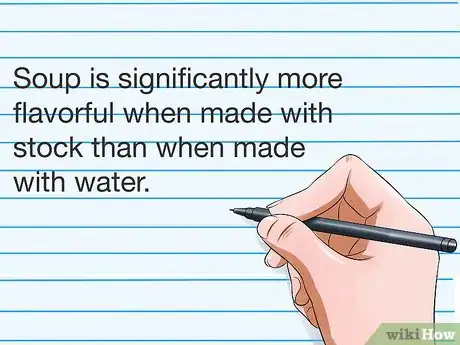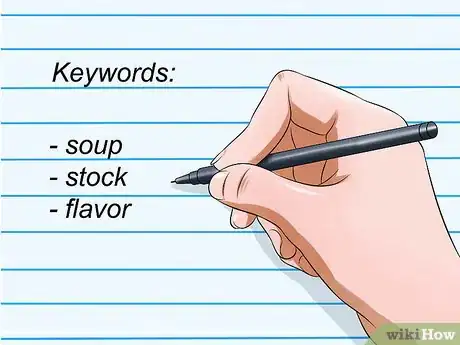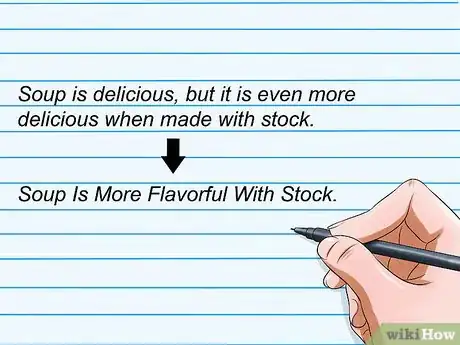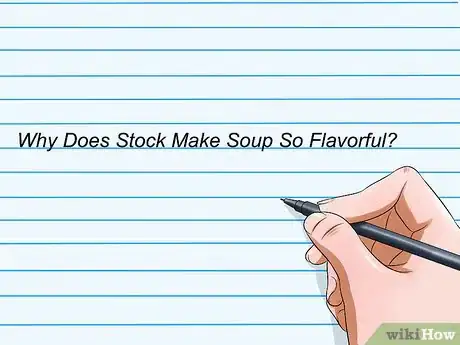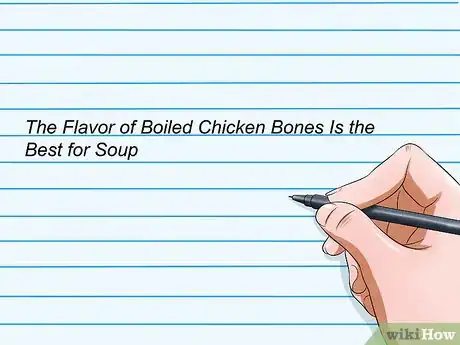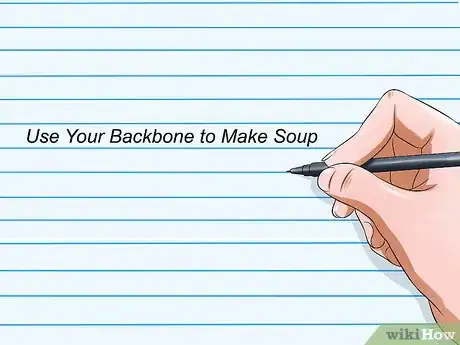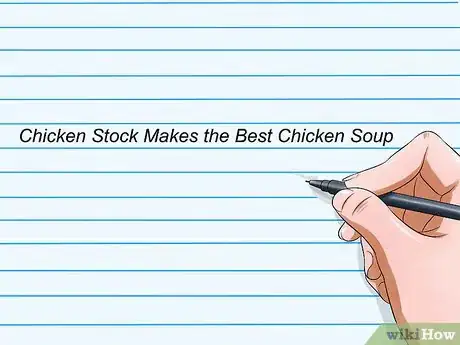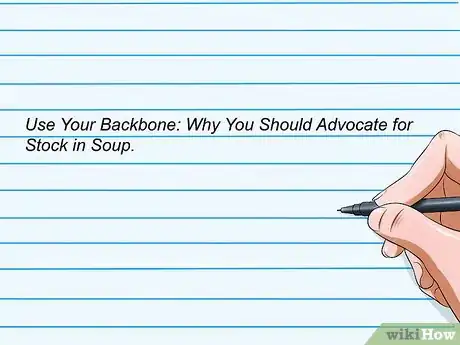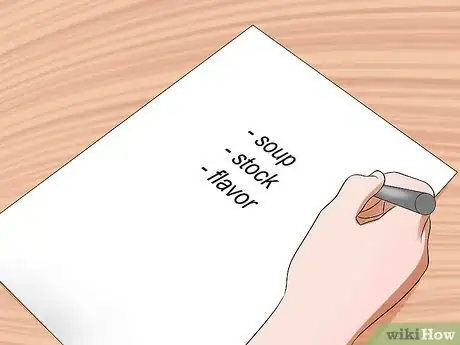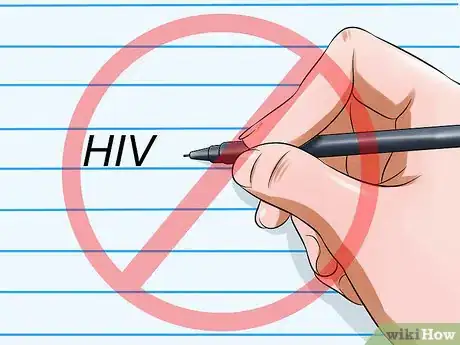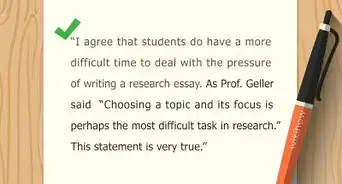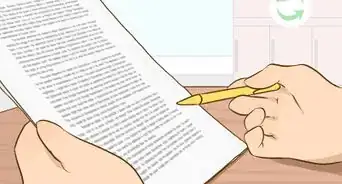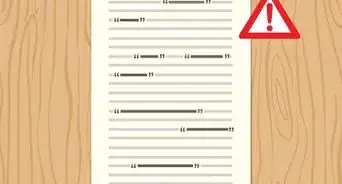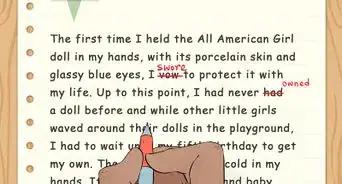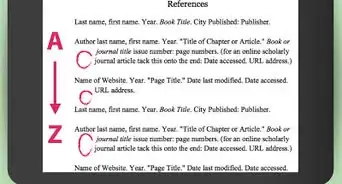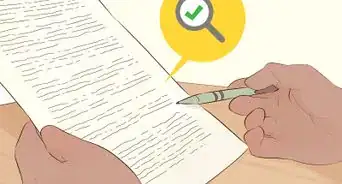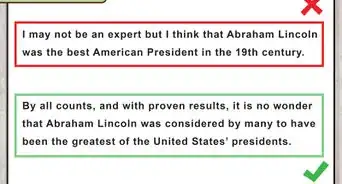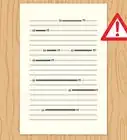This article was co-authored by Diane Stubbs. Diane Stubbs is a Secondary English Teacher with over 22 years of experience teaching all high school grade levels and AP courses. She specializes in secondary education, classroom management, and educational technology. Diane earned a Bachelor of Arts in English from the University of Delaware and a Master of Education from Wesley College.
This article has been viewed 150,223 times.
In most cases, a title for an essay is only required for college papers. A title for an argumentative essay isn't much different than a title for any other essay. You need to present what your essay is about in phrase form, as well as provide a hook to encourage the reader to read your essay. One main difference is you also need to make sure you establish your stance on the subject, so the reader knows where your argument is headed from the beginning. In order to create a strong title, you should write your essay before coming up with a title for it.
Steps
Summarizing Your Ideas
-
1Start brainstorming. Pull out a piece of paper for brainstorming. You can also work on the computer. However, writing it out can sometimes be helpful to combine and reuse ideas. Have a pen and paper ready to jot down ideas.
- Also, read through your paper. Start making notes on the main ideas. If you organized your paper well, you should have the paper divided into several main ideas.
- Write down any ideas you have about what you think should go in your title.
-
2Summarize your content. If you haven't already, make a summary of your paper. Your conclusion is usually a good summary of your paper, but you should distill it down to just the basics.
- In most cases, your thesis, or a version of it, is the best summary for the essay. The thesis should be stated at the end of your introduction, and perhaps restated at the beginning of your conclusion as well.
- Try to get it down to one sentence if possible, such as, "Soup is significantly more flavorful when made with stock than when made with water."
Advertisement -
3Make a list of keywords and phrases. What are the main ideas that make up your paper? List the words and phrases that are essential to your paper to help you decide what your title should say.[1]
- For instance, if you wrote a paper on why soup is better when made with stock than water, think about what words are essential to that paper.
- Your list of keywords might include "soup," "stock," and "flavor," as an example.
Creating a Title
-
1Think about your audience and tone. When making a title, it's important to consider your audience. If your audience is super serious, a silly title might not work. However, if you think your intended audience has a sense of humor, silly may make the perfect title.[2]
- Also, think about the tone of your essay. If it's lighthearted, a lighthearted title will fit. For instance, an essay on stock and chicken soup lends itself to lightheartedness.
- However, if your essay is very serious, stick to a serious title. For instance, if you're trying to convince people that poverty needs to end, that's a pretty serious topic and needs a serious title.
-
2Pull a sentence out. One way to create a title is to pull a sentence out of your paper that offers insight into what you're saying. You can also use your summary sentence. Sometimes a sentence will work as a title, or it will work if you shorten it up a bit.[3]
- Read over your paper. You can use this opportunity to proofread while you look for a good sentence.
- Write out any sentence that may work. For instance, one sentence that might work is "Soup is delicious, but it is even more delicious when made with stock."
- Shorten it up to work as a title: "Soup Is More Flavorful With Stock."
-
3Try a question. Sometimes, using a question as a title can help draw your reader in. Frame a descriptive title in the form of a question that your paper answers or addresses.[4]
- For instance, you could write, "Why Does Stock Make Soup So Flavorful?" That establishes your topic, as well as invites your reader into your paper.
- Just be sure you are answering the question you propose.
- Choose a different question than the one you used for your hook, if applicable.
-
4Make it playful. Your title, of course, needs to be informative. However, making it creative, too, helps draw your reader in. You may have heard this element referred to as a "hook" because you are hooking your readers into continuing with your essay.[5]
- Come up with something that is contrasting or surprising. A concrete image works well, meaning something that invokes the senses. For instance, you could write something like "The Flavor of Boiled Chicken Bones Is the Best for Soup."
- People don't necessarily think bones are tasty, but they are used to create your flavorful broth. Therefore, it's a bit surprising, but it plays into your essay.
- Try to create a title that is both short and sweet.
-
5Make a pun or use a famous saying. One way you can lead into your essay is to play with your words. For instance, make a pun. Another way is to use a famous quote, poem, or song to lead into your title.[6]
- As an example, a pun you could use would be "Use Your Backbone to Make Soup." "Backbone" is a play both on the fact that you're using stock (made from bones) and that you need to use your backbone to stand up for stock.
- As for a saying, you could use something like "Chicken Soup: Only the Opiate of the Masses If Made With Stock." "Opiate of the masses" is a reference to Karl Marx and will attract attention.
Finessing Your Title
-
1Give it some time. You've come up with an idea. Great! However, your first idea may not be your best one. Give yourself some time to play around with it.[7]
- That is, move words around to see if you can make a better statement.
- Try mixing and matching among titles that you like. Pick the parts you like best.
-
2Be specific. Being as specific as possible plays to your advantage. It prepares the reader to know exactly what is coming, which in turn, means they are more ready for your argument.[8]
- For instance, if you are discussing a specific type of soup, add that in: "Chicken Stock Makes the Best Chicken Soup."
- If you are specifically talking about homemade stock, add that in "Homemade Chicken Stock Makes the Best Chicken Soup."
- If possible, try to give the reader just an idea of which side you plan to argue in favor of in the essay.
-
3Use a subtitle. A subtitle can help you include everything you want to in your title. That is, if you have creative and informative parts, it can be hard to smash both in. If you want to use both, you can use one as the title and one as the subtitle.[9]
- The most common method is putting the creative part first as the main title, followed by the informative part in the subtitle. However, you can do it either way.
- For example, you could write: "Use Your Backbone: Why You Should Advocate for Stock in Soup."
- If the titles are on the same line, separate them by a colon. If not, you don't need the colon.
-
4Check for keywords. Make sure you've included as many of your keywords as possible. If your keywords are essential to your paper, they're essential to your title, too.[10]
- Compare your title to the list you made earlier.
-
5Ensure you've covered your topic. Read the title you've decided on. What would you think the topic of your paper is from that title? If what you say is anything different than the topic of your paper, then you need to shift it some.[11]
- In the case of an argumentative essay, that not only means that you've presented what your topic is but also what your stance on that topic is.
- Try it out on a parent. Ask her what she thinks the paper is about from your title.
-
6Skip abbreviations. When you use an abbreviation in a title, you're going to confuse your reader. Reserve them for later in your essay when you can explain them.[12]
- The exception to this rule is very common abbreviations or abbreviations that are appropriate for your audience.
- For instance, using "HIV" probably wouldn't confuse your readers.
Community Q&A
-
QuestionDo I need to write a title when writing an argumentative essay?
 Community AnswerYes. All papers should have a title. You want to give your readers an idea about what they're reading!
Community AnswerYes. All papers should have a title. You want to give your readers an idea about what they're reading!
References
- ↑ http://writing.umn.edu/sws/assets/pdf/quicktips/titles.pdf
- ↑ https://umanitoba.ca/student/academiclearning/media/Writing_a_Great_Title_NEW.pdf
- ↑ http://writing.umn.edu/sws/assets/pdf/quicktips/titles.pdf
- ↑ http://writing.umn.edu/sws/assets/pdf/quicktips/titles.pdf
- ↑ https://www.esu.edu/writing-studio/guides/hook.cfm
- ↑ https://lsa.umich.edu/sweetland/undergraduates/writing-guides/how-do-i-write-a-great-title-.html
- ↑ https://lsa.umich.edu/sweetland/undergraduates/writing-guides/how-do-i-write-a-great-title-.html
- ↑ https://lsa.umich.edu/sweetland/undergraduates/writing-guides/how-do-i-write-a-great-title-.html
- ↑ https://umanitoba.ca/student/academiclearning/media/Writing_a_Great_Title_NEW.pdf

